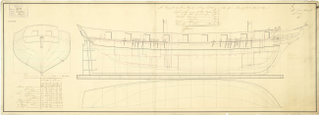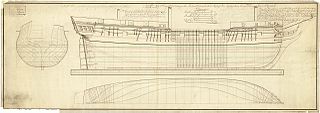
HMS Clio was a Cruizer-class brig-sloop of the Royal Navy, launched at James Betts' shipyard in Mistleythorn in Essex on 10 January 1807. Her establishment was 71 officers and men, 24 boys and 20 marines. She served in the Baltic during the Napoleonic Wars, accomplished the re-establishment of British rule on the Falkland Islands in 1833, and participated in the First Opium War. She was broken up in 1845.

The second HMS Dauntless was a Cormorant-class ship-sloop of the Royal Navy, launched in 1808. She was sold in 1823.

HMS Charybdis was a Royal Navy Cruizer-class brig-sloop built by Mark Richards and John Davidson at Hythe, and launched in 1809. She captured two American prizes during the War of 1812 before she was laid up in 1815 and sold in 1819. She apparently then became the whaler Greenwich, which made three voyages for Samuel Enderby & Sons and one for Daniel Bennett & Son. She was wrecked in the Seychelles in 1833 on her fourth whaling voyage.

HMS Scylla was an 18-gun Cruizer-class brig-sloop of the Royal Navy. The first to bear the name Scylla, she was launched in 1809 and broken up in 1846.
HMS Canso was the American letter of marque schooner Lottery, launched in 1811, that a British squadron captured in 1813. The Royal Navy took Lottery into service as HMS Canso and she served during the War of 1812 and briefly thereafter. The navy sold her in 1816.

HMS Moselle was a Cruizer-class brig-sloop of the Royal Navy, launched in 1804. She served during the Napoleonic Wars in the Mediterranean, the Caribbean, and the North American station. She was sold in 1815.

HMS Rover was a Royal Navy Cruizer-class brig-sloop laid down in 1804 but not launched until 1808. She served in the North Sea, off the north coast of Spain, in the Channel, and on the North American station. She captured two letters-of-marque and numerous merchant vessels before being laid-up in 1815. She then sat unused until she was sold in 1828. She became a whaler that made four voyages to the British southern whale fishery between 1830 and 1848. She was last listed in 1848.

Nettuno was a French Illyrien or Friedland-class brig built at Venice and launched in June 1807. HMS Unite captured her a year later off Zara. The Royal Navy took her into service as HMS Cretan. She served in the Mediterranean. She was sold in 1814. Between 1815 and 1831 she made five voyages as a whaler.
The French brig Nisus was a Palinure-class brig of the French Navy, launched in 1805. The Royal Navy captured Nisus at Guadeloupe in 1809. The British took her into service as HMS Guadaloupe, and sold her in November 1814.
HMS Constant was an Archer–class gun-brig of the Royal Navy, launched in 1801 for service against the French during the French Revolutionary and Napoleonic Wars. She was variously stationed in English home waters, the Baltic, the Caribbean, and off the coast of Spain, and was responsible for the capture of at least seven enemy vessels during her fifteen years at sea. The Royal Navy sold Constant at Chatham Dockyard in 1816.
Éole was an 18-gun corvette of the French Navy, launched, captured, and later commissioned in the Royal Navy in 1799 as HMS Nimrod after her capture by HMS Solebay. She was then "the finest and most handsome ship-sloop in the British navy". She was sold in 1811. Nimrod made three whaling voyages between 1811 and 1819. On her first she captured several American whalers. Nimrod was last listed in 1820.
HMS Foxhound was the French Navy's brig Basque, launched in 1809, that the British Royal Navy captured in 1809 and took into service as a 16-gun sloop. She had a relatively brief naval career in which she captured a number of merchant vessels. After the Navy sold her in 1816, she made some 10 or 11 whaling voyages between 1817 and 1848.
Surprise was a highly successful American privateer schooner. She was launched in 1813 and operated out of Baltimore. She captured over 40 British vessels during her brief career. In one case the capture followed a single-ship action. She was wrecked in April 1815, shortly after the end of the War of 1812.

Rifleman was a Cruizer-class brig-sloop launched in 1809 for the Royal Navy. She served in the North Sea, on the Halifax and Jamaica stations, and in the Mediterranean Sea. During her service she recaptured a Royal Navy vessel in Danish service, and two privateers. The Navy sold her in 1836 and she proceed to sail as a merchantman and whaler between 1837 and 1856.

HMS Jalouse was a Cormorant-class ship-sloop of the British Royal Navy launched in 1809 and sold in 1819. She participated in the capture of a French privateer, but spent most of her active service escorting convoys. The Navy sold her in 1819.
HMS Nimrod was a brig-sloop of the British Royal Navy, launched in 1812. She spent her war years in North American waters where she captured one small privateer, assisted in the capture of another, and captured or destroyed some 50 American vessels. After the war she captured smugglers and assisted the civil authorities in maintaining order in Tyne. She was wrecked in 1827 and so damaged that the Navy decided she was not worth repairing. A private ship-owner purchased Nimrod and repaired her. She then went on to spend some 20 years trading between Britain and Charleston, the Mediterranean, Australia, and India. She was last listed in 1851.
Three hired armed cutters named Earl Spencer served the British Royal Navy during the French Revolutionary or Napoleonic Wars. Two, both cutters, served at the same time between 1799 and 1801. A third, variously referred to as a tender or cutter, served from 1803 to 1814.
Auguste was a French 14-gun privateer commissioned in Saint-Malo in November 1811 under Pierre Jean Marie Lepeltier. She captured numerous British merchant vessels before the Royal Navy forced her in January 1814 to run onshore and wreck.
HMS Muros was launched at Chatham Dockyard in 1809. She had a relatively uneventful career though she did participate in one major campaign. She was sold in 1822 for breaking up.
HMS Martin was launched in Bermuda in 1809. Commander John Evans then commissioned her at Halifax Nova Scotia. During the War of 1812, Martin spent much of her time on the Halifax station. She captured or shared in the capture of numerous small merchant vessels. She also captured a small United States privateer, and was involved in an action with United States gunboats. After the war she conducted patrols against smugglers. She was on one of those patrols when she was wrecked in 1817.








